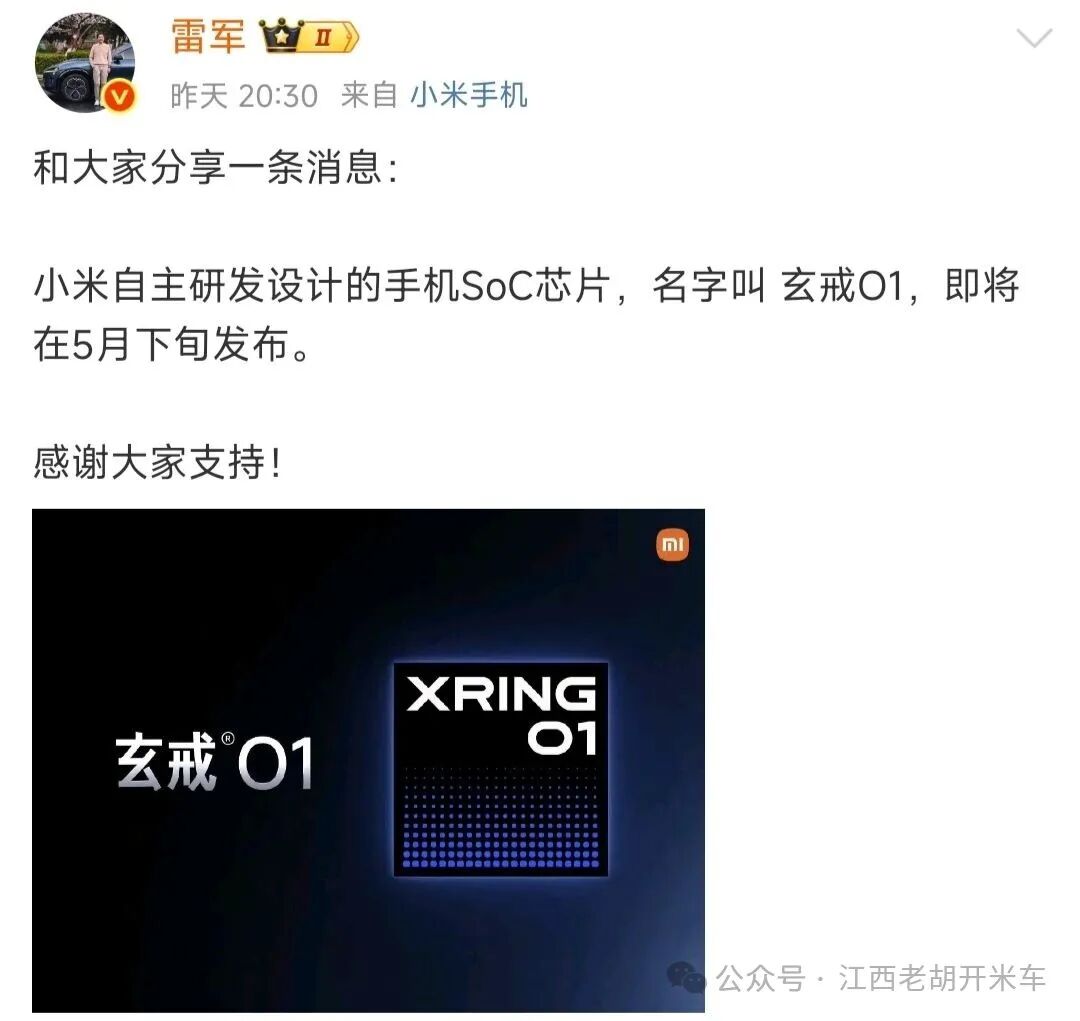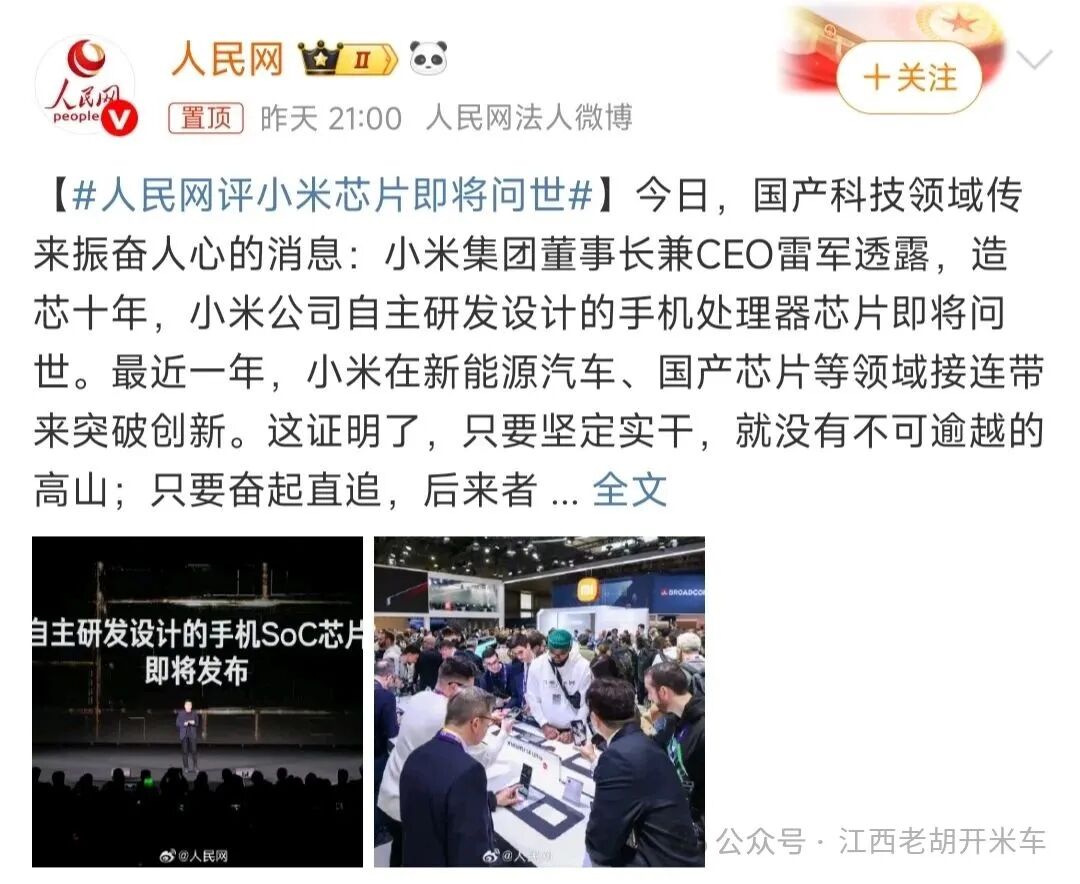Last night, Lei Jun officially announced that the Xiaomi Xuanjie chip will be released at the end of the month, directly trending on social media and sparking widespread discussion.
Xiaomi has gradually deepened its involvement in the semiconductor industry, from the early Surge S1 to the current Xuanjie chip. So, what is an SoC chip? Why does Xiaomi insist on developing its own chips? How difficult is this path?

1. What is an SoC Chip?
SoC stands for System on Chip, which is a highly integrated chip that combines multiple core components of traditional computers or electronic devices onto a single chip.
Compared to traditional multi-chip solutions, SoCs can significantly reduce power consumption, improve performance, and shrink device size.
The core components of an SoC include:
1. Central Processing Unit (CPU): Responsible for general computing, such as running mobile applications.
2. Graphics Processing Unit (GPU): Handles image rendering, affecting gaming and video performance.
3. Neural Processing Unit (NPU): Used for AI computations, such as photo optimization and voice recognition.
4. Modem: Responsible for cellular communication (5G/4G signals).
5. Image Signal Processor (ISP): Optimizes camera image quality.
6. Memory Controller: Manages access to memory (RAM) and flash storage.
7. Power Management Integrated Circuit (PMIC): Regulates chip power consumption to extend battery life.
Currently, flagship mobile chips like Apple’s A series and Qualcomm’s Snapdragon use SoC designs.

2. Xiaomi’s Chip Development Journey
Xiaomi’s journey in chip development began in 2014 with the establishment of Pinecone Electronics, and in 2017, it released its first SoC: the Surge S1, also known as the Pengpai S1, which was used in the Xiaomi 5C.
1. Surge S1: A promising start, but limited by technology and ecosystem.
– Manufactured using a 28nm process (while Qualcomm had already moved to 14nm), its performance was close to that of the Snapdragon 625.
– Supported only 4G, with modem technology relying on licensing, making it unable to compete with Qualcomm and Huawei.
– The market response was mediocre, and subsequent SoC development stagnated.
2. Shift to Specialized Chips: Surge C1, P1, G1.
Due to the high difficulty of SoC development, Xiaomi adjusted its strategy to first tackle specialized chips:
– Surge C1 (2021): An independent ISP chip that enhances image processing capabilities (used in Xiaomi MIX Fold).
– Surge P1 (2021): A fast-charging chip that supports 120W single-cell fast charging.
– Surge G1 (2022): A battery management chip that optimizes battery life (used with P1 in Xiaomi 12S Ultra).
3. Xuanjie Chip: A renewed challenge for SoC
In 2023, Xiaomi established Xuanjie Technology and increased investment in chip development. Industry speculation suggests its goals may include:
– Mid-range mobile SoCs: Similar to MediaTek’s Dimensity, avoiding high-end competition with Qualcomm and Apple.
– Automotive-grade chips: Providing intelligent driving computing power for Xiaomi’s automotive (SU7).
– AI acceleration chips: Similar to AMD, enhancing local computation capabilities for large models.

3. How Difficult is it to Create Chips at Xiaomi?
Chip development is a capital, technology, and talent-intensive “hard technology” industry, and Xiaomi faces multiple challenges:
1. High Technical Barriers
– Dependence on ARM architecture: Xiaomi needs to purchase CPU/GPU licenses from ARM to catch up later.
– Modem challenges: Developing a 5G modem is extremely complex; Huawei took 10 years to break through, and Qualcomm still monopolizes the market.
– Advanced process limitations: The cost of fabricating 7nm/5nm chips exceeds $100 million and relies on TSMC/Samsung for manufacturing.
2. Ecosystem and Patent Challenges
– Android optimization: Qualcomm/MediaTek have deep collaborations with Google, and Xiaomi needs to adapt drivers and systems independently.
– Patent litigation risks: Standard Essential Patents (SEPs) may lead to lawsuits (like the disputes between Apple and Qualcomm).
3. Investment in Capital and Talent
Currently, there is a shortage of high-end chip talent in China, and Xiaomi needs to attract talent from Qualcomm and MediaTek with high salaries.
4. Intense Market Competition
– Mobile SoCs have been divided among Qualcomm, Apple, MediaTek, and Samsung, making it difficult for new players to break through.
– In the automotive chip sector, NVIDIA, Qualcomm, and AMD also hold a competitive edge.

4. The Future of Xiaomi’s Chips: A Comeback
Despite numerous challenges, Xiaomi is directly bringing mobile SoC chips to market and will also release phones equipped with its own Xuanjie 01 chip, making a strong entry.
Xiaomi’s chip development is a “long-term battle”; the independent development of SoCs is no easy task. However, from the Surge S1 to the current Xuanjie chip, Xiaomi has demonstrated a firm determination.
In the future, if it can break through in the fields of AI and automotive chips, Xiaomi may become a new force in China’s semiconductor industry. This path is challenging but worth looking forward to.